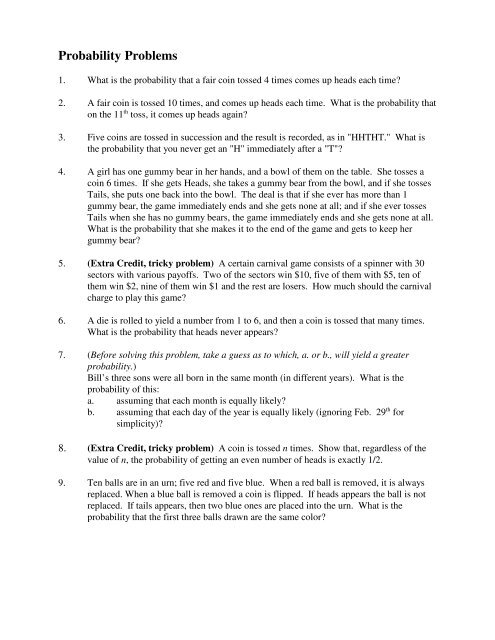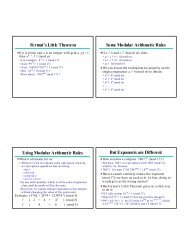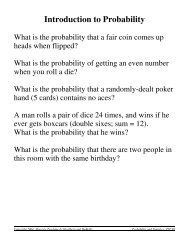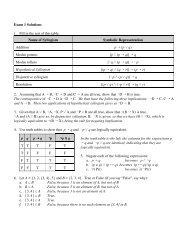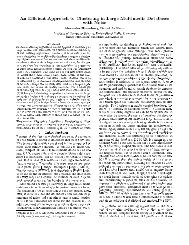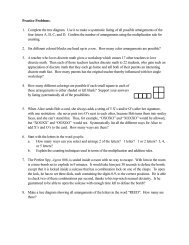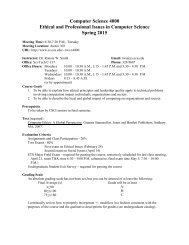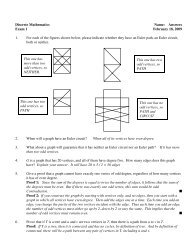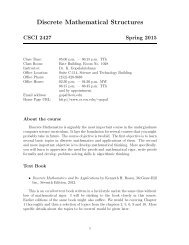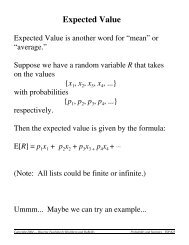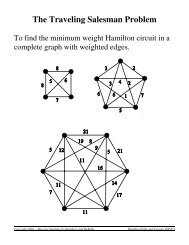Probability Problems
Probability Problems
Probability Problems
Create successful ePaper yourself
Turn your PDF publications into a flip-book with our unique Google optimized e-Paper software.
<strong>Probability</strong> <strong>Problems</strong><br />
1. What is the probability that a fair coin tossed 4 times comes up heads each time?<br />
2. A fair coin is tossed 10 times, and comes up heads each time. What is the probability that<br />
on the 11 th toss, it comes up heads again?<br />
3. Five coins are tossed in succession and the result is recorded, as in "HHTHT." What is<br />
the probability that you never get an "H" immediately after a "T"?<br />
4. A girl has one gummy bear in her hands, and a bowl of them on the table. She tosses a<br />
coin 6 times. If she gets Heads, she takes a gummy bear from the bowl, and if she tosses<br />
Tails, she puts one back into the bowl. The deal is that if she ever has more than 1<br />
gummy bear, the game immediately ends and she gets none at all; and if she ever tosses<br />
Tails when she has no gummy bears, the game immediately ends and she gets none at all.<br />
What is the probability that she makes it to the end of the game and gets to keep her<br />
gummy bear?<br />
5. (Extra Credit, tricky problem) A certain carnival game consists of a spinner with 30<br />
sectors with various payoffs. Two of the sectors win $10, five of them with $5, ten of<br />
them win $2, nine of them win $1 and the rest are losers. How much should the carnival<br />
charge to play this game?<br />
6. A die is rolled to yield a number from 1 to 6, and then a coin is tossed that many times.<br />
What is the probability that heads never appears?<br />
7. (Before solving this problem, take a guess as to which, a. or b., will yield a greater<br />
probability.)<br />
Bill’s three sons were all born in the same month (in different years). What is the<br />
probability of this:<br />
a. assuming that each month is equally likely?<br />
b. assuming that each day of the year is equally likely (ignoring Feb. 29 th for<br />
simplicity)?<br />
8. (Extra Credit, tricky problem) A coin is tossed n times. Show that, regardless of the<br />
value of n, the probability of getting an even number of heads is exactly 1/2.<br />
9. Ten balls are in an urn; five red and five blue. When a red ball is removed, it is always<br />
replaced. When a blue ball is removed a coin is flipped. If heads appears the ball is not<br />
replaced. If tails appears, then two blue ones are placed into the urn. What is the<br />
probability that the first three balls drawn are the same color?
Complement <strong>Probability</strong><br />
It is often easier to find the probability of something not happening than to find the probability of<br />
it happening. This is useful, because if p is the probability of an event happening, and q is the<br />
probability of it not happening, then p + q = 1.<br />
For example, suppose we wish to find the probability that when a die is rolled three times a six<br />
will appear at least once. Finding this probability directly is tedious. So let’s consider the<br />
complement probability, that is, the probability that a six will never appear. On each toss, the<br />
probability that a six does not appear is 5/6, so the probability that a six never appears is (5/6) 3 .<br />
Thus the probability that a six will appear is 1 – (5/6) 3 .<br />
10. A man rolls a pair of dice 24 times, and wins if he ever gets boxcars (double sixes; sum =<br />
12). What is the probability that he wins?<br />
11. For this problem, assume that there are 365 possible birthdays, and that each is equally<br />
likely.<br />
a. What is the probability that there are two people in this room with the same<br />
birthday?<br />
b. What is the largest number of people that can be in a room so that the probability<br />
of two having the same birthday is less than 50%?<br />
c. What is the smallest number of people that can be in a room so that the probability<br />
of two having the same birthday is greater than 50%?<br />
12. It’s been said that if you put a billion monkeys in front of a billion typewriters for a<br />
billion years, they will eventually type the complete works of Shakespeare. Let’s<br />
consider this... Suppose that our billion monkeys have keyboards with just capital letters,<br />
three punctuation symbols and a space bar, and that each is typed with equal probability.<br />
a. Their first task is to type<br />
TO BE OR<br />
alone on a single sheet of paper. Assume they have been trained to insert a page,<br />
type 8 (random) characters, and remove the page. What is the probability that one<br />
of our billion monkeys will get this right on the first try?<br />
b. What is the probability that one of the monkeys will get it right within the first<br />
1000 tries?<br />
c. Now suppose that each monkey can type twelve characters per second, and that<br />
putting paper into and taking paper out of a typewriter takes no time. How long<br />
would it take before the probability that one of our monkeys typed<br />
TO BE OR NOT<br />
alone on a single sheet of paper exceeded 50%? Assume they have been trained<br />
to insert a page, type 12 (random) characters, and remove the page. For this<br />
n n x<br />
problem, you may wish to use the approximation ( 1 + x ) ≈ e ≈ 1 + nx ,<br />
valid for small x, positive or negative.<br />
d. How about<br />
TO BE, OR NOT TO BE. THAT IS THE QUESTION.<br />
after they are retrained to type 43 characters on the page?


